TASK-SPECIFIC ACUTE AND ADAPTIVE CHANGES IN ACCURACY OF VISUAL FEEDBACK CONTROL OF BODY POSITION
Erika Zemková, Dušan Hamar
Department of Sports Kinanthropology, Faculty of Physical Education and Sport, Comenius University Bratislava, Slovakia
Abstract
Aim The study evaluates acute and adaptive changes in accuracy of visual feedback control of body position during task-oriented sensorimotor exercise. Methods. Subjects (16 PE students and 6 individuals with functional disbalances) were provided by feedback on COM displacement on a computer screen while standing on dynamometric platform. Their task was to trace, by shifting COM, a curve flowing either in vertical or horizontal direction. The deviation of instant COP position from the curve was recorded at 100 Hz by means of the system FiTRO Sway Check. In the first case, the test consisted of twenty 30-seconds trials randomly performing in each direction. After its completion, additional 6 trials (one to each direction) were performed every 5 minutes. The same task was performed also under dynamic conditions (standing on unstable surface). In the second, the training during initial four weeks consisted of conventional exercises (4 sessions/week) followed by including visual feedback exercises into the program during next eight weeks (2 of 4 sessions/week). Adaptive changes in sensorimotor parameters were evaluated every week using two different tests – visually guided COM tracking and target-matching task. Prior to and after the training also static balance with eyes open and eyes closed was evaluated. Parameters of balance were registered by means of the posturography system FiTRO Sway Check based on dynamometric platform. Results. Distance of sway trajectory from the curve decreased in both antero-posterior and medio-lateral direction when repeatedly performing visually-guided COM tracking task. However, a significant (p ≤ 0.01) improvement was observed only during initial seven trials. After cessation of practice its values slightly decreased over a period of 10 minutes and then gradually increased toward 30 minute of recovery. When performing visually-guided COM tracking task under dynamic conditions, there was a greater decline in mean COP distance from the curve over repeated trials than during stance on stable platform (46.1% and 26.3%, respectively). Results of the training study showed that COP distance from both horizontally and vertically flowing curves measured during visually-guided COM tracking task only slightly decreased (8.7%) during initial four weeks. However, its greater decline was observed from the 5th to 8th (10.6%) and from 9th to 12th week of the training (14.5%) when visual feedback exercises were included into the training program. Similar trend was observed also in case of visually-guided COM target-matching task. Contrary to this, no significant changes were found in parameters of balance registered in static conditions under and without visual control. Conclusions. Task-oriented sensorimotor exercise leads to more precise perception of COM position and regulation its movement in both antero-posterior and medio-lateral direction. However, learning effect is greater when performing visually-guided COM tracking task under dynamic than under static conditions. Conventional training consisting of balance exercises does not improve visual feedback control of body position until given feedback in the second and third phase of the program.
Key words: Acute adjustments – Chronic adaptations – Sensorimotor parameters – Task-oriented sensorimotor exercise – Visual feedback control of body position
INTRODUCTION
Besides traditional balance exercises, recently platform feedback exercises became a part of athletic training and rehabilitation. For this purpose the systems are being designed that provide visual or auditory biofeedback to subjects regarding the locus of their centre of pressure (COP). These systems usually consist of two force plates allowing determine the weight distribution on each foot, a computer screen allowing visualization of the COP, and software providing training protocols and data analysis. Some units allow auditory feedback in addition to the visual feedback in response to errors in performance. However, platform feedback exercises have been found (Barclay-Goddard et al., 2004) to improve stance symmetry but not postural stability in standing and clinical balance outcomes (Berg Balance Scale and Timed Up and Go).
Therefore more sophisticated methods, namely those enabling both training and assessment of sensorimotor function are needed. Promising seems to be those closer to functional activities like task-oriented sensorimotor exercises performing on either stable or unstable platform equipped with PC system for feedback monitoring of COM movement (Hamar, 2008). Advantage of the system is that can be used not only for training but also for diagnostic purposes. In addition, there are variety of task settings like „Hit the target“ or „Trace the curve“ by horizontal shifting of COM.
In the first case, subjects have to hit the target randomly appearing in one of the corners of the screen by horizontal shifting of COM in appropriate direction. The test consists of 2 sets of 20 responses while better result is taken for the evaluation. Time, distance, and velocity of COP trajectory between stimulus appearance and its hit by visually-guided COM movement on the screen are registered by means of the system FiTRO Sway Check based on dynamometric platform (www.fitronic.sk).
In the second, subjects are provided by feedback on COM displacement on a computer screen while standing on dynamometric platform. Their task is to trace, by shifting COM, a curve flowing either in horizontal or vertical direction. The test consists of three 30-seconds trials randomly performing in antero-posterior and medio-lateral direction. The deviation of instant COP position from the curve is recorded at 100 Hz by means of the system FiTRO Sway Check (www.fitronic.sk).
Analysis of repeated measures showed (Zemková, Hamar, 2010/a) measurement error of 8.8 % for visually-guided COM target-matching task and 7.0 % for visually-guided COM tracking task, which is within the range comparable to common motor tests. Test-retest correlation coefficient between repeated measurements in different days was 0.81 for visually-guided COM target-matching task and 0.83 for visually-guided COM tracking task, which signify good reliability. Also the testing protocols were standardized by analysing of sensorimotor parameters under various conditions, e.g. using different velocity and positioning of the curve tracking by a visually-guided COM.
Our previous study (Zemková, Hamar, 2010/b) showed that task-oriented sensorimotor exercise acutely decreases the response time and distance of COP movement, and increases the COP velocity registered during standing on unstable spring-supported platform equipped with PC system for feedback monitoring of COM movement. It means that with repeated trials subjects responded to visual stimuli faster and more precise by horizontal shifting of COM in one of the four directions according to position of stimulus on the screen. However, such an acute enhancement of visual feedback control of body position during practice was not beneficial for improvement of static and dynamic balance. On the other hand, 3 weeks of task-oriented sensorimotor training has been found (Zemková, Hamar, 2008) to contribute to more precise perception of COM position and regulation its movement leading to faster responses to visual stimuli, as well as to more rapid postural sway adjustments in altered surface conditions.
However, there is no information on acute and training effect of task-oriented sensorimotor exercise on accuracy of visual feedback control of COP movement in antero-posterior (A-P) and medio-lateral (M-L) direction. Therefore the aim of the study was a) to analyze the mean COP distance from vertically and horizontally flowing curve during visually-guided COM tracking task over repeated trials under both static and dynamic conditions; and b) to evaluate the effect of 12 weeks of conventional training consisting of balance exercises and task-oriented sensorimotor training on visual feedback control of body position in individuals with functional disbalances.
METHODS
Subjects
In the first study a group of 16 PE students (age 22.1 ± 1.8 y, height 177.9 ± 9.8 cm, and weight 75.8 ± 10.3 kg) and in the second study a group of 6 subjects with functional disbalances (age 24.1 ± 2.7 y, height 181.2 ± 12.7 cm, and weight 78.6 ± 12.9 kg) volunteered to participate in the study. All of them were informed on the procedures and on the main purpose of the study. The procedures presented were in accordance with the ethical standards on human experimentation.
Study setting
Subjects were provided by feedback on COM displacement on a computer screen while standing on dynamometric platform. Their task was to trace, by shifting COM, a curve flowing either in vertical or horizontal direction (Figure 1). The deviation of instant COP position from the curve was recorded at 100 Hz by means of the system FiTRO Sway Check developed in our department by Hamar (2007-09).
In the first case, the test consisted of twenty 30-seconds trials randomly performing in each direction. After its completion, additional 6 trials (one to each direction) were performed every 5 minutes. The same task was performed also under dynamic conditions (standing on unstable surface).
In the second, the training during initial four weeks consisted of conventional exercises (4 sessions/week) followed by including visual feedback exercises into the program during next eight weeks (2 of 4 sessions/week). Adaptive changes in sensorimotor parameters were evaluated every week using two different tests. In the first, subjects were provided by feedback on COM displacement on a computer screen while standing on dynamometric platform. Their task was to trace, by shifting COM, a curve flowing either in vertical or horizontal direction. The test consisted of three 30-seconds trials randomly performing in A-P and M-L direction. The deviation of instant COP position from the curve was recorded at 100 Hz by means of the system FiTRO Sway Check. In the second, subjects had to hit the target by horizontal shifting of COM in one of the four directions according to position of stimulus on the screen. The test consisted of 2 sets of 20 stimuli. Time, distance, and velocity of sway trajectory between stimulus appearance and its hit by visually-guided COM movement on the screen were registered by means of the system FiTRO Sway Check based on dynamometric platform. Prior to and after the training also static balance with eyes open and eyes closed was evaluated. The COP velocity was registered at 100 Hz by means of the posturography system, FiTRO Sway Check, based on dynamometric platform. Subjects were instructed to minimize postural sway by standing as still as possible.
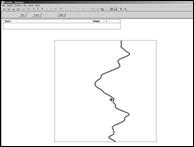
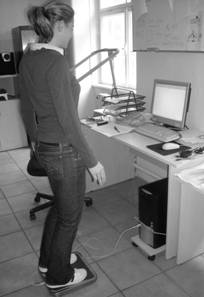
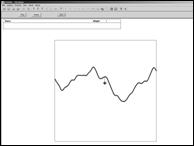
Figure 1 Task execution: trace a curve flowing either in vertical or horizontal direction by visually-guided COM movement on the screen while standing on dynamometric platform
Statistical analysis
Ordinary statistical methods including average and standard deviation were used. A paired t-test was employed to determine the statistical
significance of differences between pre- and post-exercise values of examined abilities, p < 0.05 was considered significant.
RESULTS
Results showed (Figure 2) that the distance of sway trajectory from the curve decreased in both antero-posterior and medio-lateral direction when repeatedly performing visually-guided COM tracking task. However, a significant (p ≤ 0.01) improvement was observed only during initial seven trials. After cessation of practice its values slightly decreased over a period of 10 minutes and then gradually increased toward 30 minute of recovery.
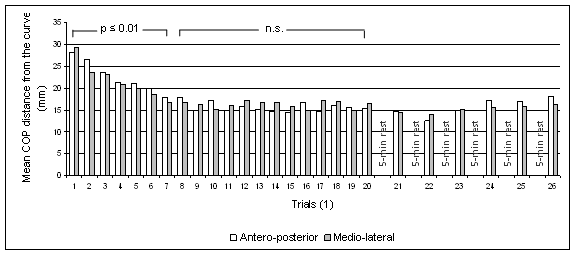
Figure 2 Mean COP distance from horizontally and vertically flowing curve over repeated trials
Furthermore, when performing the visually-guided COM tracking task under static conditions, the distance of sway trajectory from the curve decreased from 1st to 8th trial with no further improvement within 20th trial. On the other hand, its values registered under dynamic conditions (stance on wobble board) gradually decreased from the 1st to 20th trial (Figure 3). Consequently, there was greater decline its values over repeated trials (26.3% and 46.1%, respectively). This effect is very probably due to more efficient regulation of COM movement primarily by rotation of ankle joints during stance on unstable platform.
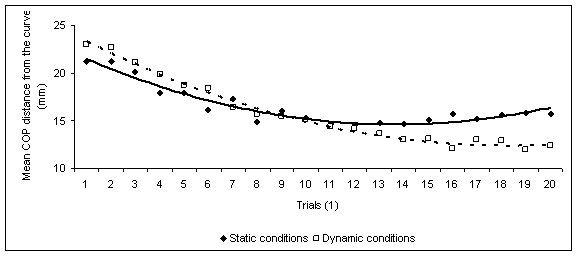
Figure 3 Mean COP distance from the curve registered under static and dynamic conditions, respectively
Results of the training study showed (Figure 4) that COP distance from both horizontally and vertically flowing curves measured during visually-guided COM tracking task only slightly decreased (8.7%) during initial four weeks. However, its greater decline was observed from the 5th to 8th (10.6%) and from 9th to 12th week of the training (14.5%) when visual feedback exercises were included into the training program.
Similar trend was observed also in case of visually-guided COM target-matching task. However, there were significant individual differences, as shown an example in Figure 5. The subject with good initial performance learned faster as compared to the one with slower response time and longer distance of sway movement registered prior to the training (29.3% and 17.0%, respectively).
Contrary to this, no significant changes in parameters of balance registered in static conditions under and without visual control were found. However, it should be noted that exercise program led to the enhancement of other regularly measured functional outcomes.
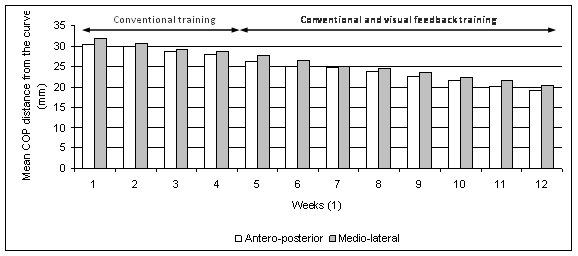
Figure 4 Mean COP distance from horizontally and vertically flowing curve during 12 weeks of different exercise programs
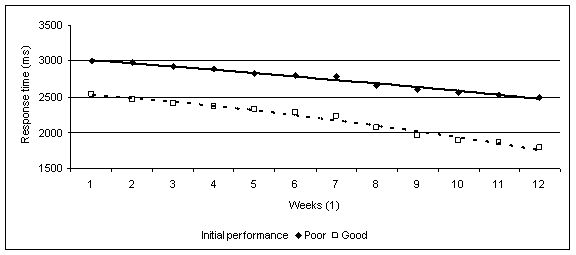
Figure 5 Response time in two individuals with different initial performance level during 12 weeks of exercise program
DISCUSSION
It has been found that conventional training program consisting of balance exercises does not improve visual feedback control of body position. Providing visual feedback of COM movement on a computer screen during training contributed to more precise perception of COM position and regulation its movement during different task-oriented sensorimotor exercises. These findings are in agreement with earlier study of Gibson (1953) who documented that practice with some type of reinforcement (e.g., visual or auditory feedback) results in greater perceptual improvements.
Such an improvement of visual feedback control of body position may be due to a) improved the ability to more precise perceive COM position through use the proprioceptors, b) improved the motor ability to perform more accurate body movement, and/or c) improved „proprioceptive memory“ with repeated trials. Since tracing randomly flowing curves by visually-guided COM movement on the screen likely eliminate the potential confounding factor of proprioceptive memory, the effect may be ascribed mainly to the improvement of sensorimotor functions. Though it is not possible to separate sensory and motor part of this task, one may expect mainly improvement of proprioceptive acuity with practice. It is beacuse the same receptors share on weight transmission from one to other leg namely during regulation of COM movement in medio-lateral direction (cutaneous and GTO receptors) and discrimination of ankle joint position namely during regulation of COM movement in antero-posterior direction (muscle spindle and cutaneous receptors). However, besides physiological adaptations (e.g., improvement in proprioceptive function) also mechanical changes in technique (e.g., more precise regulation of COM movement with less effort) may be assumed.
Several studies investigated the relationship between level of motor skills and proprioceptive acuity. Our previous study showed (Zemková, Hamar, 2008) that improvement of more precise perception of COM position and regulation its movement after visual feedback training contributes also to better ability to maintain balance under dynamic conditions. On the other hand, improvement of dynamic balance after instability agility training does not enhance accuracy of visual feedback control of body position (Zemková et al., 2009). These findings indicate that task-oriented sensorimotor exercises represent more effective means for improvement of both reflexive responses of balance and voluntary movement than combined agility-balance exercises. Hence, task-oriented sensorimotor exercises represent a suitable means for enhancement of neuromuscular performance enabling more rapid postural sway adjustments in altered surface conditions.
Since a limited sample size was used in this study, further investigations are needed to prove the efficiency of exercises based on visual feedback control of body position on sensorimotor performance in individuals with deteriorated coordination due to disease or injury. Also its role in facilitation of learning of other skilled movements should be investigated.
Promising seems to results of recent studies (e.g., Sayenko et al., 2009) documenting that balance training with visual feedback improves postural control in people with spinal cord injury during both standing and walking. According to authors such improvements are due to an optimalization of postural synergies and a sensory re-weighting during and after the training. Such retraining of balance function after injury using visual feedback exercises may complement existing rehabilitation methods. It may be of potential use also in elderly population, for decreasing risk of falling and reduction of health-related consequences.
CONCLUSIONS
Task-oriented sensorimotor exercise temporary improves accuracy of visual feedback control of COP movement in both antero-posterior and medio-lateral direction. However, learning effect is greater when performing visually-guided COM tracking task under dynamic than under static conditions.
Conventional training program consisting of balance exercises does not improve visual feedback control of body position. Providing visual feedback of COM movement on a computer screen during training contributes to more precise perception of COM position and regulation its movement during different task-oriented sensorimotor exercises.
REFERENCES
- Barclay-Goddard R, Stevenson T, Poluha W, Moffatt ME, Taback SP (2004). Force platform feedback for standing balance training after stroke. Cochrane Database Syst Rev; 18(4): CD004129.
- Gibson EJ (1953). Improvement in perceptual judgements as a function of controlled practice or training. Physiological Bulletin; 50(6): 401-31.
- Hamar D, Schickhofer P, Zemková E, Gažovič O, Böhmerová Ľ, Grmanová K, Pelikánová J (2007-09). Nonharmonic proprioceptive stimulation as a means for the enhancement of neuromuscular function. The project of the Scientific Grant Agency of the Ministry of Education of the Slovak Republic and the Slovak Academy of Sciences; No. 1/4504/07.
- Hamar D (2008). Performačné testy stability postoja. National Congress of Sports Medicine „Aktuálne problémy telovýchovného lekárstva“. Trenčín: Slovak Society of Sports Medicine; 12-3.
- Sayenko D, Alekhina M, Vette A, Nakazawa K, Popovic M (2009). Balance training with visual feedback can improve balance abilities in people with spinal cord injury. XIX Coference of the International Society for Posture and Gait Research. Bologna: 105-6.
- Zemková E, Hamar D (2008). The effect of task-oriented proprioceptive training on parameters of neuromuscular function. 5th International Posture Symposium „Translation of posture mechanisms for rehabilitation“. Smolenice Castle: 55.
- Zemková E, Cepková A, Potočárová L, Hamar D (2009). The effect of 8-week instability agility training on sensorimotor performance in untrained subjects. 14th Annual Congress of the European College of Sport Science. Oslo: 617.
- Zemková E, Hamar D (2010/a). Reliability and sensitivity of the test based on visually-guided COM tracking task. Acta Facultatis Educationis Physicae Universitatis Comenianae (in press).
- Zemková E, Hamar D (2010/b). The effect of task-oriented sensorimotor exercise on visual feedback control of body position and body balance. Human Movement (submitted).
AKUTNE I ADAPTIVNE PROMJENE PRECIZNOSTI VIZUELNE POVRATNE INFORMACIJE O KONTROLI POLOŽAJA TIJELA U SPECIFIČNIM ZADACIMA
Sažetak
Cilj. Istraživanjem se procjenjuju akutne i adaptivne promjene u preciznosti povratne informacije o kontroli položaja tijela za vrijeme vježbi orjentisanih na senzoromotorne zadatke. Metode. Ispitanici (16 studenata fakulteta za tjelesni odgoj i 6 pojedinaca sa funkcionalnim disbalansom) su izabrani na osnovu povratne informacije pomjeranja COM-a (tačke) na monitoru dok ispitanik stoji na dinamometrijskoj platform. Njihov zadatak je bio da prate krivu, pomjerajući COM (tačku), u vertikalnom i horizontalnom smjeru. Devijacija trenutnog COP-a (centar pritiska na ploču) od krive je snimano na 100 Hz pomoću sistema FiTRO Sway Check. U prvom slučaju, test se sastojao od 30 sekundnih pokušaja nasumično izvođenih u svakom smjeru. Poslije završetka, dodatnih 6 pokušaja (jedan u svakom smjeru) su izvođeni svakih 5 minuta. Isti zadatak je izveden pod dinamičkim uslovima (stajanje na nestabilnoj površini). U drugom slučaju, trening za vrijeme početnih 4 sedmice sastojao se od primjene konvencionalnih vježbi (4 X sedmično) poslije kojih su uključene vježbe sa vizuelnom povratnom informacijom narednih osam sedmica (2 X 4 treninga sedmično). Adaptivne promjene u sensoromotornim parametrima su procjenjivane svake sedmice pomoću dva različita testa – praćenje vizuelno vođenog COM-a i zadatak “pogađanja” mete. Prije i poslije treninga, također je testirana statička ravnoteža sa zatvorenim i otvorenim očima. Parametri ravnoteže su registrovani pomoću posturograf sistema FiTRO Sway Check zasnovanog na dinamometrijskoj platformi. Rezultati. Razdaljina od ispupčenja trajektorije od krivulje smanjena je u oba, anteroposterior i medio-lateralnom smjeru, za vrijeme uzastopnog ponavljanja zadatka sa vizuelno vođenom tačkom. Značajno (p ≤ 0.01) poboljšanje je uočljivo samo za vrijeme početnih sedam pokušaja. Poslije završetka vježbe njegove vrijednosti nešto opadaju u periodu od 10 minuta te se postepeno povećavaju prema tridesetoj minuti oporavka. Za vrijeme izvedbe praćenja vizuelno vođene tačke u dinamičkim uslovima, postojalo je veće opadanje u srednjoj vrijednosti COP (centra pritiska na ploču) razdaljine od krivulje kroz ponovljene pokušaje u odnosu na položaj na stabilnoj platformi (46,1 % i 26,3 %). Rezultati istraživanja treninga pokazuju da COP razdaljina od oba, horizontalnog i vertikalnog toka krivulje, mjerenih tokom izvedbe praćenja vizuelno vođene tačke, nešto opada (8,7 %) za vrijeme početnih četiri sedmice. Kako god, njegovo veće smanjenje se primjećuje od 5. do 8. (10,6 %) i od 9. do 12.(14,5 %) sedmice treninga, kada su vježbe sa vizuelnom povratnom informacijom bile uključene u program. Sličan trend se primjećuje i u slučaju vizuelno vođene tačke u zadatku “pogađanja” mete. Suprotno ovome, nisu pronađene statistički značajne promjene u parametrima ravnoteže registrovanih u statičkim uslovima sa i bez vizuelne kontrole. Zaključak. Vježbe sa senzoromotornim zadacima upućuju na precizniju percepciju položaja COM-a i regulaciju njegovog kretanja u oba smjera; anterio-posteriornom i medio-lateralnom. Effekti usvajanja su veći kod izvedbe zadataka sa praćenjem vizuelno vođene tačke u dinamičkim uslovima u odnosu na statičke. Konvencionalni trening, sastavljen od vježbi ravnoteže, ne poboljšava kontrolu vizuelne povratne informacije o položaju tijela kao onaj u drugoj i trećoj fazi trenažnog programa.
Ključne riječi: akutna prilagodba, hronična adaptacija, senzoromotorni parametri, vježbe sa senzoromotornim zadacima, vizuelna povratna informacija o kontroli položaja tijela
Acknowledgment:
This project was supported through a Scientific Grant Agency of the Ministry of Education of Slovak Republic and the Slovak Academy of Sciences (No. 1/0611/08).
Correspodence:
Assoc. Prof. Erika Zemková, Ph.D.
Faculty of Physical Education and Sport
Comenius University
Nábr. arm. gen. L. Svobodu 9
814 69 Bratislava
Slovakia
E-mail: zemkova@yahoo.com
Tel: +421-2-54411624